High-Noise Grayscale Image Denoising Using an Improved Median Filter for the Adaptive Selection of a Threshold
Abstract
1. Introduction
2. Two-Dimensional Maximum Shannon Entropy
3. Improved TSETMF Algorithm
3.1. Improved Self-Adaptive Median Filter
3.2. TSETMF Concept
3.3. TSETMF Process
4. Experimental Results and Discussion
4.1. Assessment Methods
4.1.1. PSNR
4.1.2. SSIM
4.2. Results and Discussion
4.2.1. Contrastive Denoising with 95% High-Density Noise
4.2.2. Contrastive Denoising with Continuous Increase in Noise Density
5. Conclusions
Supplementary Materials
Author Contributions
Funding
Institutional Review Board Statement
Informed Consent Statement
Data Availability Statement
Conflicts of Interest
References
- Chen, J.; Zhan, Y.; Cao, H. Adaptive sequentially weighted median filter for image highly corrupted by impulse noise. IEEE Access 2019, 7, 158545–158556. [Google Scholar] [CrossRef]
- Kumar, S.; Singh, S.; Kumar, J. Live detection of face using machine learning with multi-feature method. Wirel. Pers. Commun. 2018, 103, 2353–2375. [Google Scholar] [CrossRef]
- Liu, W.; Yang, S.; Ye, Z.; Huang, Q.; Huang, Y. An image segmentation method based on two-dimensional entropy and chaotic lightning attachment procedure optimization algorithm. Int. J. Pattern Recognit. Artif. Intell. 2020, 34, 2054030. [Google Scholar] [CrossRef]
- Mahdaoui, A.E.; Ouahabi, A.; Moulay, M.S. Image denoising using a compressive sensing approach based on regularization constraints. Sensors 2022, 22, 2199. [Google Scholar] [CrossRef] [PubMed]
- Frosio, I.; Borghese, N.A. Statistical based impulsive noise removal in digital radiography. IEEE Trans. Med. Imaging 2008, 28, 3–16. [Google Scholar] [CrossRef]
- Goceri, E. Evaluation of denoising techniques to remove speckle and Gaussian noise from dermoscopy images. Comput. Biol. Med. 2022, 152, 106474. [Google Scholar] [CrossRef]
- Garnett, R.; Huegerich, T.; Chui, C.; He, W. A universal noise removal algorithm with an impulse detector. IEEE Trans. Image Process. 2005, 14, 1747–1754. [Google Scholar] [CrossRef]
- Sulaiman, S.N.; Mat Isa, N.A.; Yusoff, I.A.; Ahmad, F. Switching-based clustering algorithms for segmentation of low-level salt-and-pepper noise–corrupted images. Signal Image Video Process. 2015, 9, 387–398. [Google Scholar] [CrossRef]
- Thanh, D.N.H.; Hai, N.H.; Prasath, V.B.S.; Hieu, L.M.; Tavares, J.M.R.S. A two-stage filter for high density salt and pepper denoising. Multimed. Tools Appl. 2020, 79, 21013–21035. [Google Scholar] [CrossRef]
- Li, T.; Wang, W.; Xu, L.; Feng, X. Image denoising using low-rank dictionary and sparse representation. In Proceedings of the 2014 Tenth International Conference on Computational Intelligence and Security, Kunming, China, 15–16 November 2014; pp. 228–232. [Google Scholar]
- Lin, T.C. A new adaptive center weighted median filter for suppressing impulsive noise in images. Inf. Sci. 2007, 177, 1073–1087. [Google Scholar] [CrossRef]
- Vijayarajan, R.; Muttan, S. Iterative relaxed median filter for impulse noise removal and validation of fcm clustering using cluster error index in median filtered MR images. In Proceedings of the 4th ObCom International Conference on Recent Trends in Computing, Communication and Information Technology, Vellore, India, 9–11 December 2011; pp. 792–801. [Google Scholar]
- Thilagavathi, M.; Deepa, P. An efficient dictionary learning algorithm for 3D Medical Image Denoising based on SADCT. In Proceedings of the 2013 International Conference on Information Communication and Embedded Systems (ICICES), Chennai, India, 21–22 February 2013; pp. 442–447. [Google Scholar]
- Shah, Z.H.; Müller, M.; Wang, T.C.; Scheidig, P.M.; Schneider, A.; Schüttpelz, M.; Huser, T.; Schenck, W. Deep-learning based denoising and reconstruction of super-resolution structured illumination microscopy images. Photonics Res. 2021, 9, B168–B181. [Google Scholar] [CrossRef]
- Obidin, M.V.; Serebrovski, A.P. Signal denoising with the use of the wavelet transform and the Kalman filter. J. Commun. Technol. Electron. 2014, 59, 1440–1445. [Google Scholar] [CrossRef]
- Yu, H.; Zhao, L.; Wang, H. Image denoising using trivariate shrinkage filter in the wavelet domain and joint bilateral filter in the spatial domain. IEEE Trans. Image Process. 2009, 18, 2364–2369. [Google Scholar] [PubMed]
- Uzan, A.; Rivenson, Y.; Stern, A. Speckle denoising in digital holography by nonlocal means filtering. Appl. Opt. 2013, 52, A195–A200. [Google Scholar] [CrossRef]
- Teng, L.; Li, H.; Yin, S. Modified pyramid dual tree direction filter-based image denoising via curvature scale and nonlocal mean multigrade remnant filter. Int. J. Commun. Syst. 2018, 31, e3486. [Google Scholar] [CrossRef]
- Erkan, U.; Gökrem, L.; Enginoğlu, S. Different applied median filter in salt and pepper noise. Comput. Electr. Eng. 2018, 70, 789–798. [Google Scholar] [CrossRef]
- Sree, P.S.J.; Kumar, P.; Siddavatam, R.; Verma, R. Salt-and-pepper noise removal by adaptive median-based lifting filter using second-generation wavelets. Signal Image Video Process. 2013, 7, 111–118. [Google Scholar] [CrossRef]
- Toh, K.K.V.; Isa, N.A.M. Noise adaptive fuzzy switching median filter for salt-and-pepper noise reduction. IEEE Signal Process. Lett. 2009, 17, 281–284. [Google Scholar] [CrossRef]
- Shukla, A.K.; Bhateja, V.; Verma, R.L.; Alam, M.S. An Improved Directional Weighted Median Filter for Restoration of Images Corrupted with High Density Impulse Noise. In Proceedings of the 2014 International Conference on Reliability Optimization and Information Technology (ICROIT), Faridabad, India, 6–8 February 2014; pp. 506–511. [Google Scholar]
- Peng, B.; Zhou, Y.; Li, Q.; Lin, M.; Weng, J.; Zeng, Q. FPGA Implementation of Low-Latency Recursive Median Filter. In Proceedings of the 2022 International Conference on Field-Programmable Technology (ICFPT), Hong Kong, China, 5–9 December 2022; pp. 1–7. [Google Scholar]
- Gupta, V.; Chaurasia, V.; Shandilya, M. Random-valued impulse noise removal using adaptive dual threshold median filter. J. Vis. Commun. Image Represent. 2015, 26, 296–304. [Google Scholar] [CrossRef]
- Kumar, S.; Raja, R.; Mahmood, M.R.; Choudhary, S. A Hybrid Method for the Removal of RVIN Using Self Organizing Migration with Adaptive Dual Threshold Median Filter. Sens. Imaging 2023, 24, 9. [Google Scholar] [CrossRef]
- Goyal, P.; Chaurasia, V.; Meena, O.P. Impulse Noise Removal with Zero’s Padding by Median Based Adaptive Filter. In Proceedings of the 2017 International Conference on Recent Innovations in Signal Processing and Embedded Systems (RISE), Bhopal, India, 27–29 October 2017; pp. 78–81. [Google Scholar]
- Hanel, R.; Thurner, S.; Gell-Mann, M. How multiplicity determines entropy and the derivation of the maximum entropy principle for complex systems. Proc. Natl. Acad. Sci. USA 2014, 111, 6905–6910. [Google Scholar] [CrossRef] [PubMed]
- Abramov, R. A practical computational framework for the multidimensional moment-constrained maximum entropy principle. J. Comput. Phys. 2006, 211, 198–209. [Google Scholar] [CrossRef]
- Panda, R.; Swain, M.; Naik, M.K.; Agrawal, S.; Abraham, A. A Novel Practical Decisive Row-Class Entropy-Based Technique for Multilevel Threshold Selection Using Opposition Flow Directional Algorithm. IEEE Access 2022, 10, 110473–110484. [Google Scholar] [CrossRef]
- Zou, Y.; Zhang, J.; Upadhyay, M.; Sun, S.; Jiang, T. Automatic image thresholding based on Shannon entropy difference and dynamic synergic entropy. IEEE Access 2020, 8, 171218–171239. [Google Scholar] [CrossRef]
- Chiranjeevi, K.; Jena, U.R.; Harika, A. Image Compression Using Shannon Entropy-Based Image Thresholding. In Proceedings of the 3rd International Conference on Computational Intelligence in Data Mining (ICCIDM), Bhubaneswar, India, 10–11 December 2016; pp. 101–110. [Google Scholar]
- Maleki, Y.K.; Safizadeh, M.S.; Khajavi, M.N.; Payganeh, G.; Shuruni, S. Over Hang Slant Cracked Rotor Vibration Signal Processing Based on Discrete Wavelet Transform. In Proceedings of the 2016 13th International Multi-Conference on Systems, Signals & Devices (SSD), Leipzig, Germany, 21–24 March 2016; pp. 672–676. [Google Scholar]
- Lin, T.C.; Yu, P.T. Thresholding noise-free ordered mean filter based on Dempster-Shafer theory for image restoration. IEEE Trans. Circuits Syst. I Regul. Pap. 2006, 53, 1057–1064. [Google Scholar]
- Duque, D.; Garzón, J.; Gharbi, T. A study of dispersion in chromatic confocal microscopy using digital image processing. Opt. Laser Technol. 2020, 131, 106414. [Google Scholar] [CrossRef]
- Kim, D.; Kim, C. Contrast enhancement using combined 1-D and 2-D histogram-based techniques. IEEE Signal Process. Lett. 2017, 24, 804–808. [Google Scholar] [CrossRef]
- Manda, M.P.; Kim, H.S. A fast image thresholding algorithm for infrared images based on histogram approximation and circuit theory. Algorithms 2020, 13, 207. [Google Scholar] [CrossRef]
- Zhang, H.; Liu, H.; Shang, Z.; Li, R. Robust Image Denoising with an Improved Wavelet Threshold Method. In Proceedings of the 2015 6th IEEE International Conference on Software Engineering and Service Science (ICSESS), Beijing, China, 23–25 September 2015; pp. 301–304. [Google Scholar]
- George, G.; Oommen, R.M.; Shelly, S.; Philipose, S.S.; Varghese, A.M. A Survey on Various Median Filtering Techniques for Removal of Impulse Noise from Digital Image. In Proceedings of the 2018 Conference on Emerging Devices and Smart Systems (ICEDSS), Tiruchengode, India, 2–3 March 2018; pp. 235–238. [Google Scholar]
- Zhang, D.L.; Huang, D.N.; Yu, P.; Yuan, Y. Translation-invariant wavelet denoising of full-tensor gravity–gradiometer data. Appl. Geophys. 2017, 14, 606–619. [Google Scholar] [CrossRef]
- Kubota, R.; Suetake, N. Distribution distance-based threshold auto-tuning method for switching median filter. IEICE Electron. Expr. 2010, 7, 1310–1316. [Google Scholar] [CrossRef][Green Version]
- Tan, X.; Jiang, J.; Zha, D. Threshold Switch Filter Design and Its Implementation in Image Denoising. In Proceedings of the 5th International Conference on Machine Vision (ICMV)—Computer Vision, Image Analysis and Processing, Wuhan, China, 20–21 October 2012; pp. 326–332. [Google Scholar]
- Zhang, J.; Liao, Y.; Yan, L. An Improved Image Thresholding Method Based on Two-Dimensional Histogram. In Proceedings of the 2018 13th World Congress on Intelligent Control and Automation (WCICA), Changsha, China, 4–8 July 2018; pp. 1623–1628. [Google Scholar]
- Sahoo, P.K.; Arora, G. A thresholding method based on two-dimensional Renyi’s entropy. Pattern Recognit. 2004, 37, 1149–1161. [Google Scholar] [CrossRef]
- Yu, C.; Dian-Ren, C.; Yang, L.; Lei, C. Otsu’s Thresholding Method Based on Gray Level-Gradient Two-Dimensional Histogram. In Proceedings of the 2010 2nd International Asia Conference on Informatics in Control, Automation and Robotics (CAR 2010), Wuhan, China, 6–7 March 2010; pp. 282–285. [Google Scholar]
- Celik, T. Two-dimensional histogram equalization and contrast enhancement. Pattern Recognit. 2012, 45, 3810–3824. [Google Scholar] [CrossRef]
- Kharazmi, O.; Contreras-Reyes, J.E.; Balakrishnan, N. Jensen–Fisher information and Jensen–Shannon entropy measures based on complementary discrete distributions with an application to Conway’s game of life. Physica D 2023, 453, 133822. [Google Scholar] [CrossRef]
- Kumar, R.; Singh, J.; Sharma, S.; Li, C.; Królczyk, G.; Eldin, E.M.T.; Wojciechowski, S. Identification of localized defects and fault size estimation of taper roller bearing (NBC_30205) with signal processing using the Shannon entropy method in MATLAB for automobile industries applications. Heliyon 2022, 8, e12053. [Google Scholar] [CrossRef] [PubMed]
- Yang, W.; Cai, L.; Wu, F. Image segmentation based on gray level and local relative entropy two-dimensional histogram. PLoS ONE 2020, 15, e0229651. [Google Scholar] [CrossRef]
- Saraiva, P. On Shannon entropy and its applications. Kuwait J. Sci. 2023, 50, 194–199. [Google Scholar] [CrossRef]
- Tsai, H.H.; Chang, B.M.; Lin, X.P. Using decision tree, particle swarm optimization, and support vector regression to design a median-type filter with a 2-level impulse detector for image enhancement. Inf. Sci. 2012, 195, 103–123. [Google Scholar] [CrossRef]
- Chen, B.; Cui, J.; Xu, Q.; Shu, T.; Liu, H. Coupling denoising algorithm based on discrete wavelet transform and modified median filter for medical image. J. Central South Univ. 2019, 26, 120–131. [Google Scholar] [CrossRef]
- Sinha, P.K.; Hong, Q.H. An improved median filter. IEEE Trans. Med. Imaging 1990, 9, 345–346. [Google Scholar] [CrossRef]
- Erkan, U.; Enginoğlu, S.; Thanh, D.N.H.; Hieu, L.M. Adaptive frequency median filter for the salt and pepper denoising problem. IET Image Process. 2020, 14, 1291–1302. [Google Scholar] [CrossRef]
- Ganesh, M.S.R.; Kadali, K.S.; Bhukya, R.; Palleswari, Y.T.R.; Siva, A.; Pragaspathy, S. Design of Decision Based Recursive Weighted Median Filter with Exponential Weights. In Proceedings of the 1st International Conference on Applied Mathematics, Modeling and Simulation in Engineering (AMSE), Virtual, 15–16 September 2021; p. 12016. [Google Scholar]
- Guo, S.; Wang, G.; Han, L.; Song, X.; Yang, W. COVID-19 CT image denoising algorithm based on adaptive threshold and optimized weighted median filter. Biomed. Signal Process. Control 2022, 75, 103552. [Google Scholar] [CrossRef] [PubMed]
- Xie, Y.; Zhu, Z.; Zhang, X.; Wang, Q. An Adaptive Median Filter Using Local Texture Information in Images. In Proceedings of the 2014 IEEE/ACIS 13th International Conference on Computer and Information Science (ICIS), Taiyuan, China, 4–6 June 2014; pp. 177–180. [Google Scholar]
- Nalli, P.K.; Kadali, K.S.; Bhukya, R.; Palleswari, Y.T.R.; Siva, A.; Pragaspathy, S. Design of Exponentially Weighted Median Filter Cascaded with Adaptive Median Filter. In Proceedings of the 1st International Conference on Applied Mathematics, Modeling and Simulation in Engineering (AMSE), Virtual, 15–16 September 2021; p. 12020. [Google Scholar]
- Jana, B.R.; Thotakura, H.; Baliyan, A.; Sankararao, M.; Deshmukh, R.G.; Karanam, S.R. Pixel density based trimmed median filter for removal of noise from surface image. Appl. Nanosci. 2023, 13, 1017–1028. [Google Scholar] [CrossRef]
- Kunsoth, R.; Biswas, M. Modified Decision Based Median Filter for Impulse Noise Removal. In Proceedings of the 2016 International Conference on Wireless Communications, Signal Processing and Networking (WiSPNET), Chennai, India, 23–25 March 2016; pp. 1316–1319. [Google Scholar]
- Meng, Y.; Zhang, J. A Novel Gray Image Denoising Method Using Convolutional Neural Network. IEEE Access 2022, 10, 49657–49676. [Google Scholar] [CrossRef]
- Kodak Lossless True Color Image Suite. Available online: http://r0k.us/graphics/kodak/ (accessed on 1 July 2023).
- TEST IMAGES. Available online: https://ccia.ugr.es/cvg/dbimagenes/ (accessed on 1 July 2023).
- National Microbiology Data Center. Available online: http://nmdc.cn/nCov/en/ (accessed on 1 July 2023).
- Qi, H.; Tan, S.; Li, Z. Anisotropic Weighted Total Variation Feature Fusion Network for Remote Sensing Image Denoising. Remote Sens. 2022, 14, 6300. [Google Scholar] [CrossRef]
- Wang, L.; Shi, Y.; Li, H. Anti-EMI noise digital filter design for a 60-kW five-level SiC inverter without fiber isolation. IEEE Trans. Power Electron. 2017, 33, 13–17. [Google Scholar] [CrossRef]
- Alanazi, T.M.; Berriri, K.; Albekairi, M.; Ben Atitallah, A.; Sahbani, A.; Kaaniche, K. New Real-Time High-Density Impulsive Noise Removal Method Applied to Medical Images. Diagnostics 2023, 13, 1709. [Google Scholar] [CrossRef]
- Garg, B. An adaptive minimum-maximum value-based weighted median filter for removing high density salt and pepper noise in medical images. Int. J. Ad Hoc Ubiquitous Comput. 2020, 35, 84–95. [Google Scholar] [CrossRef]

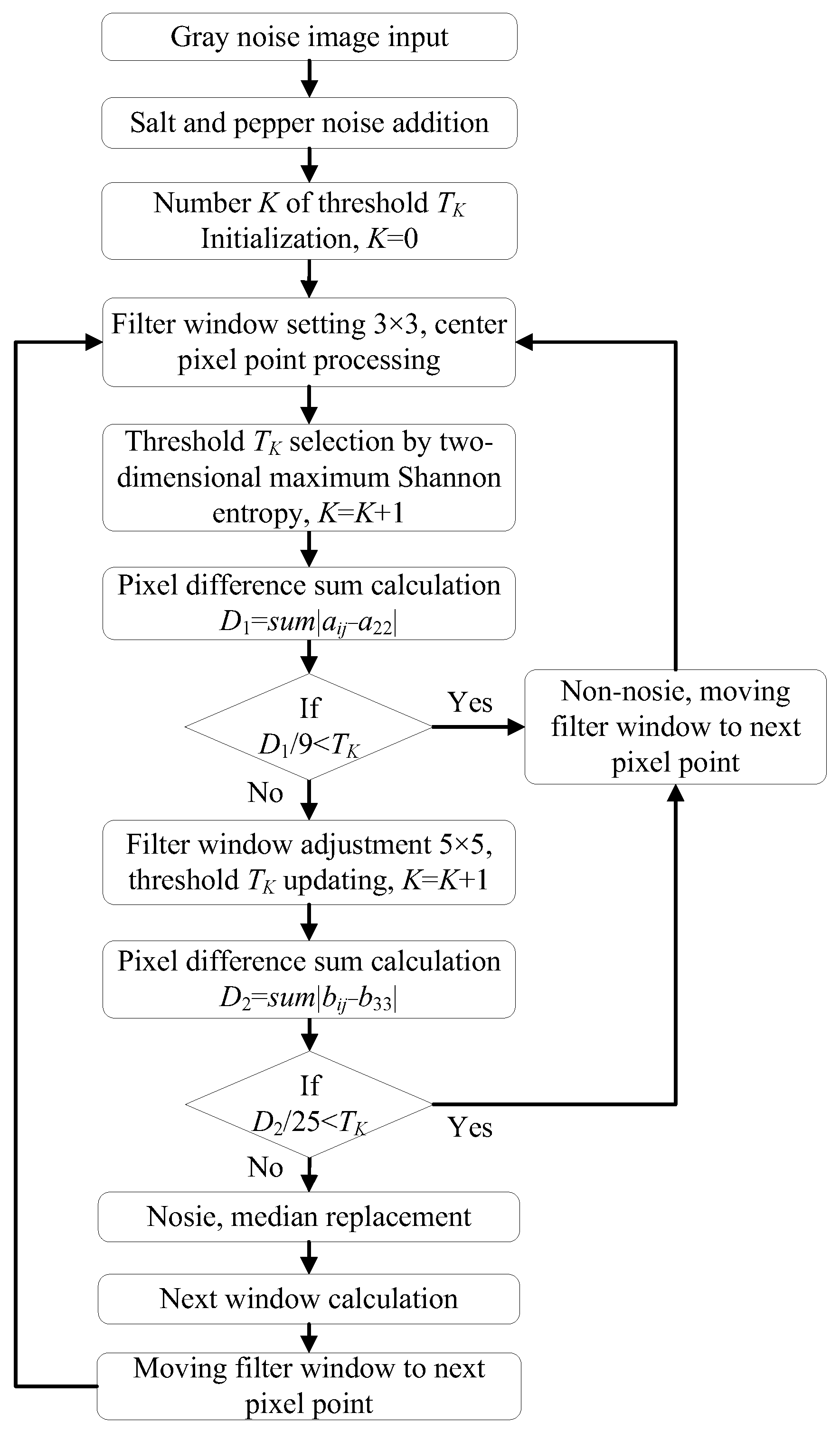
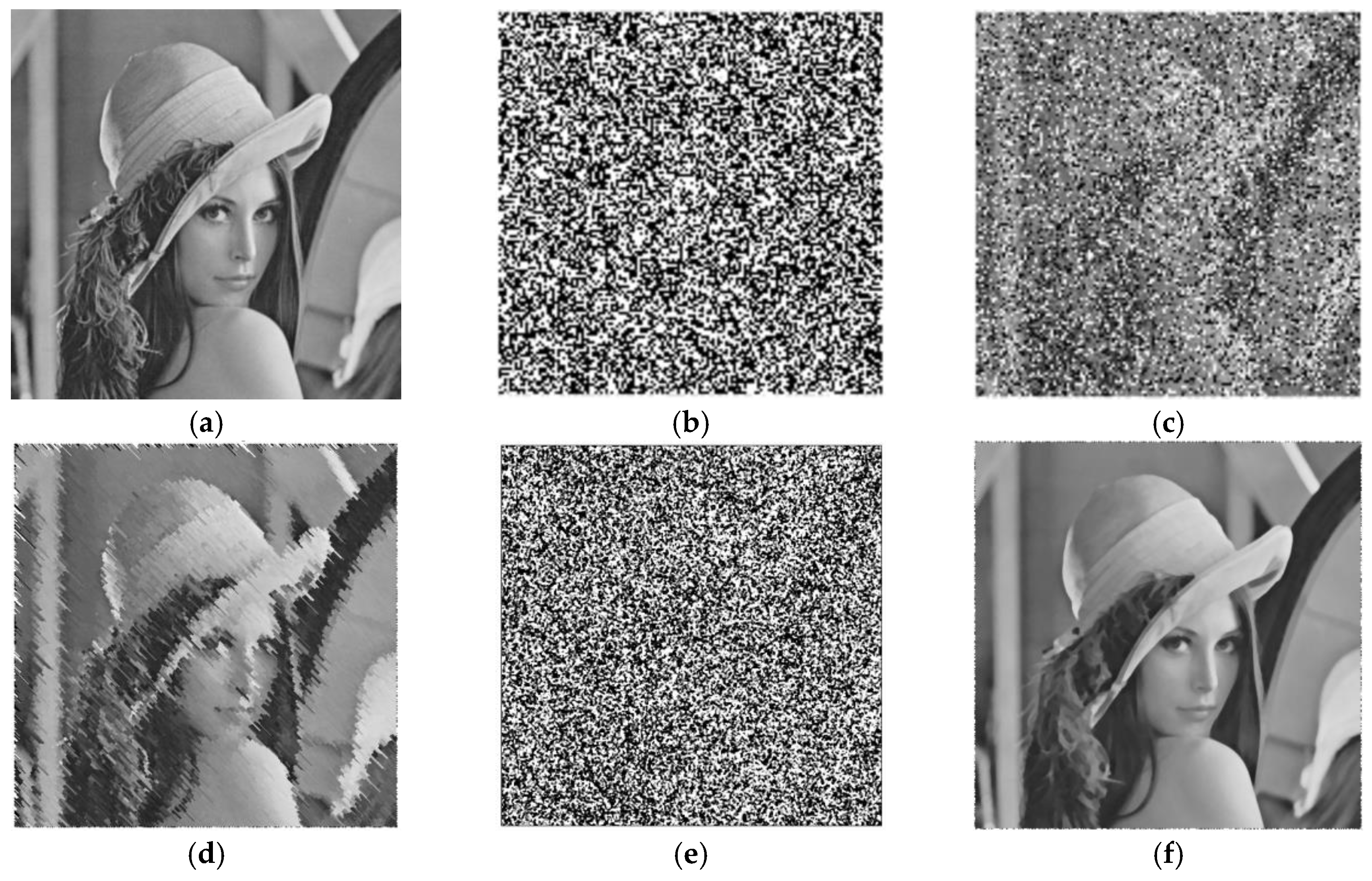


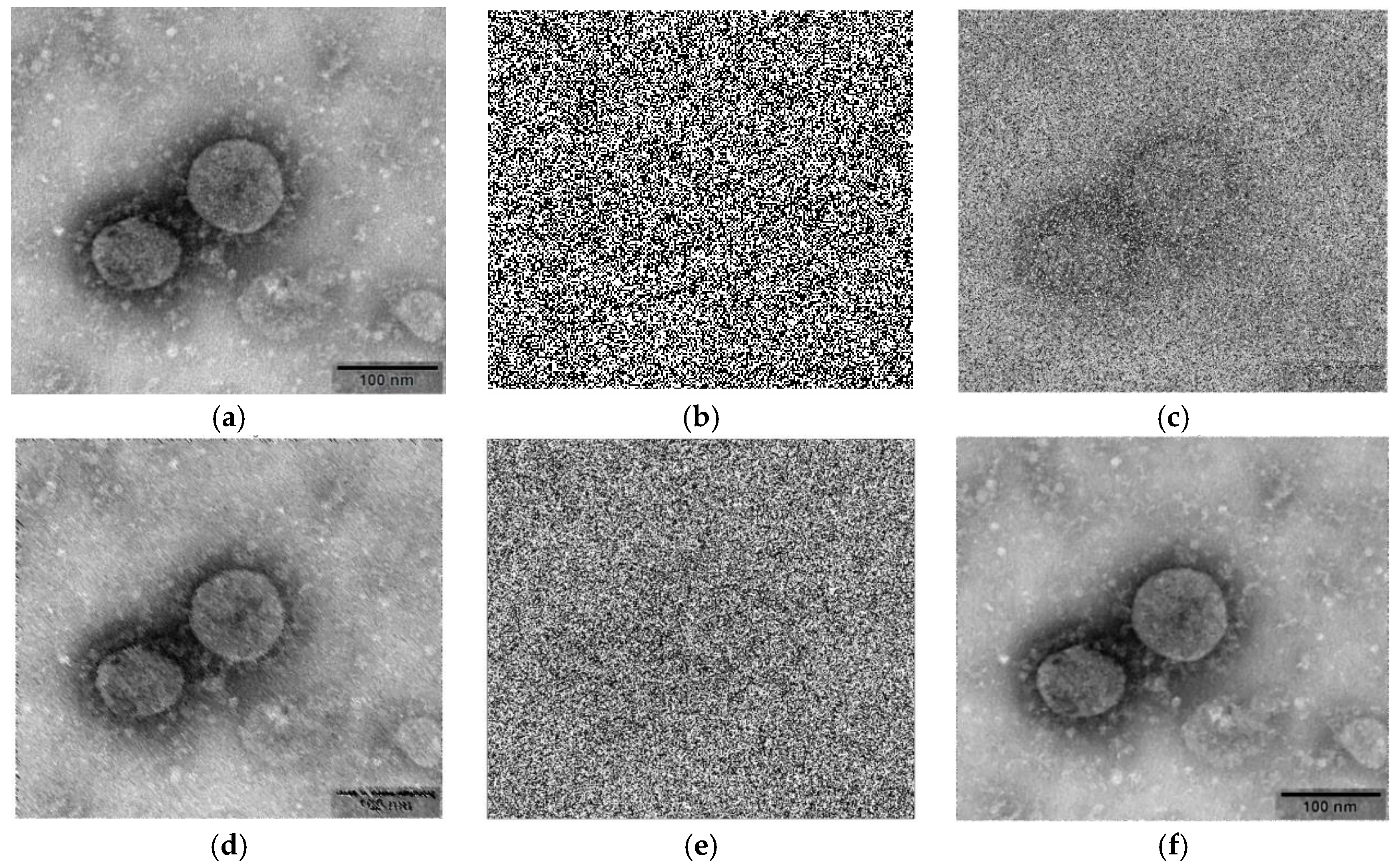
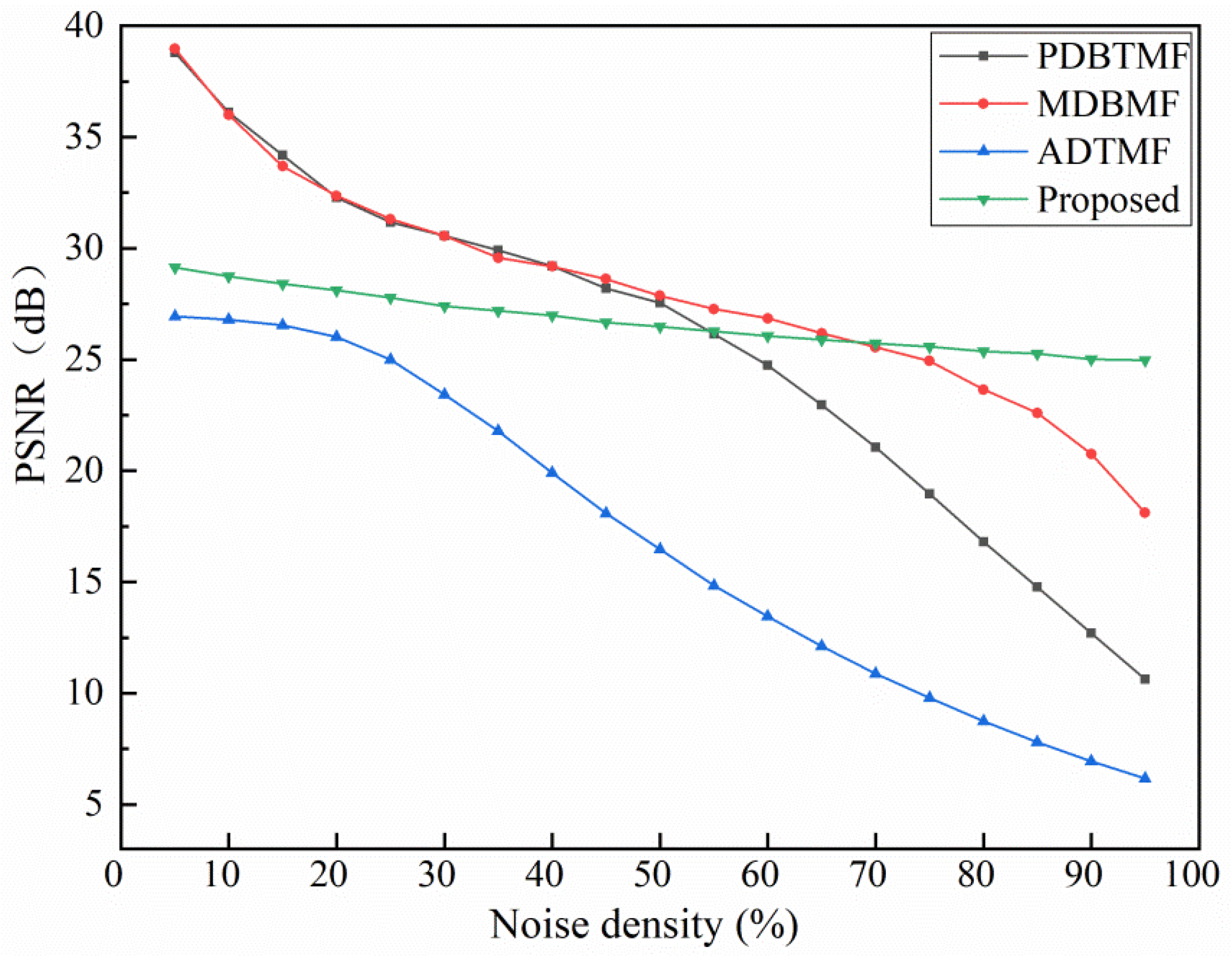

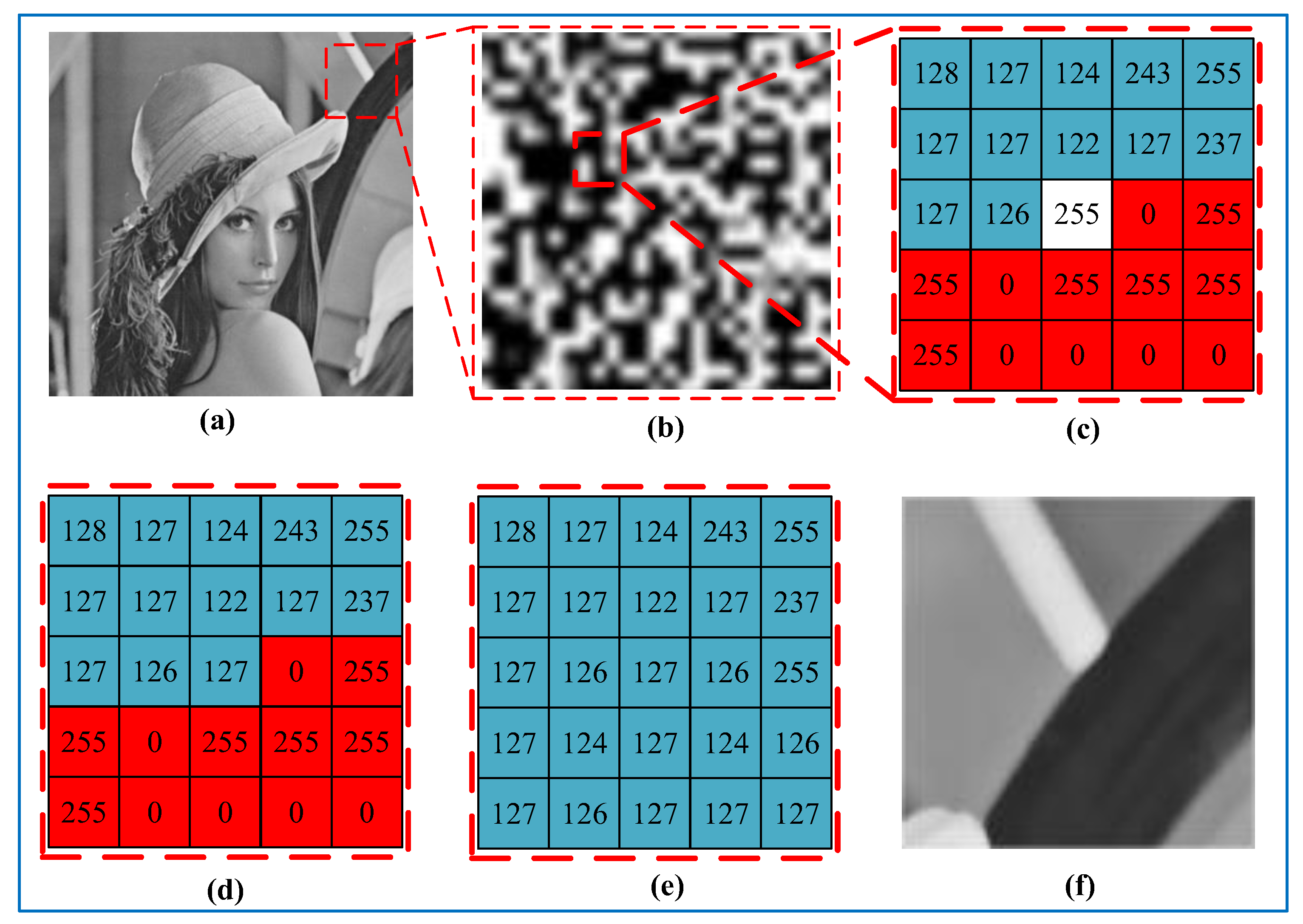

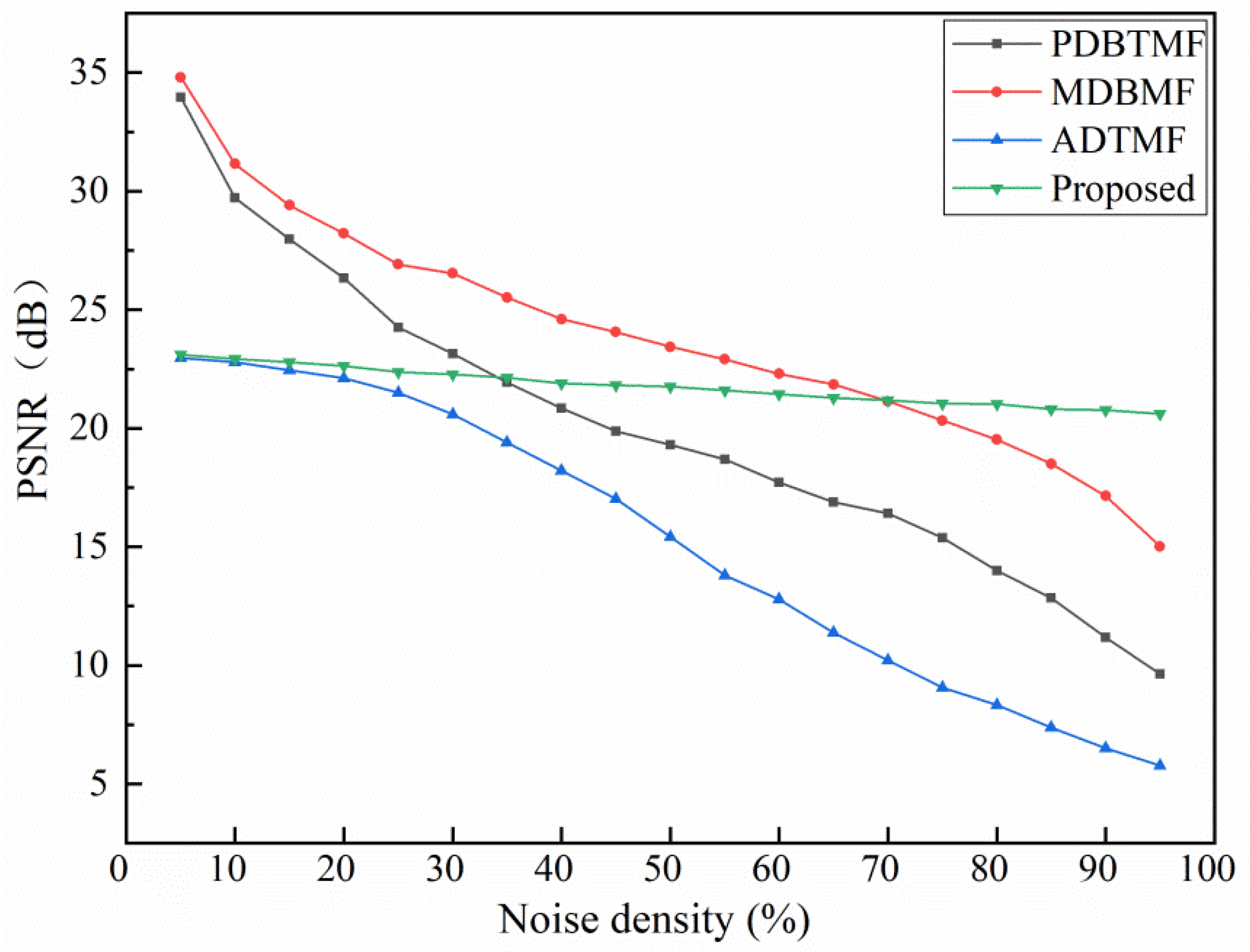
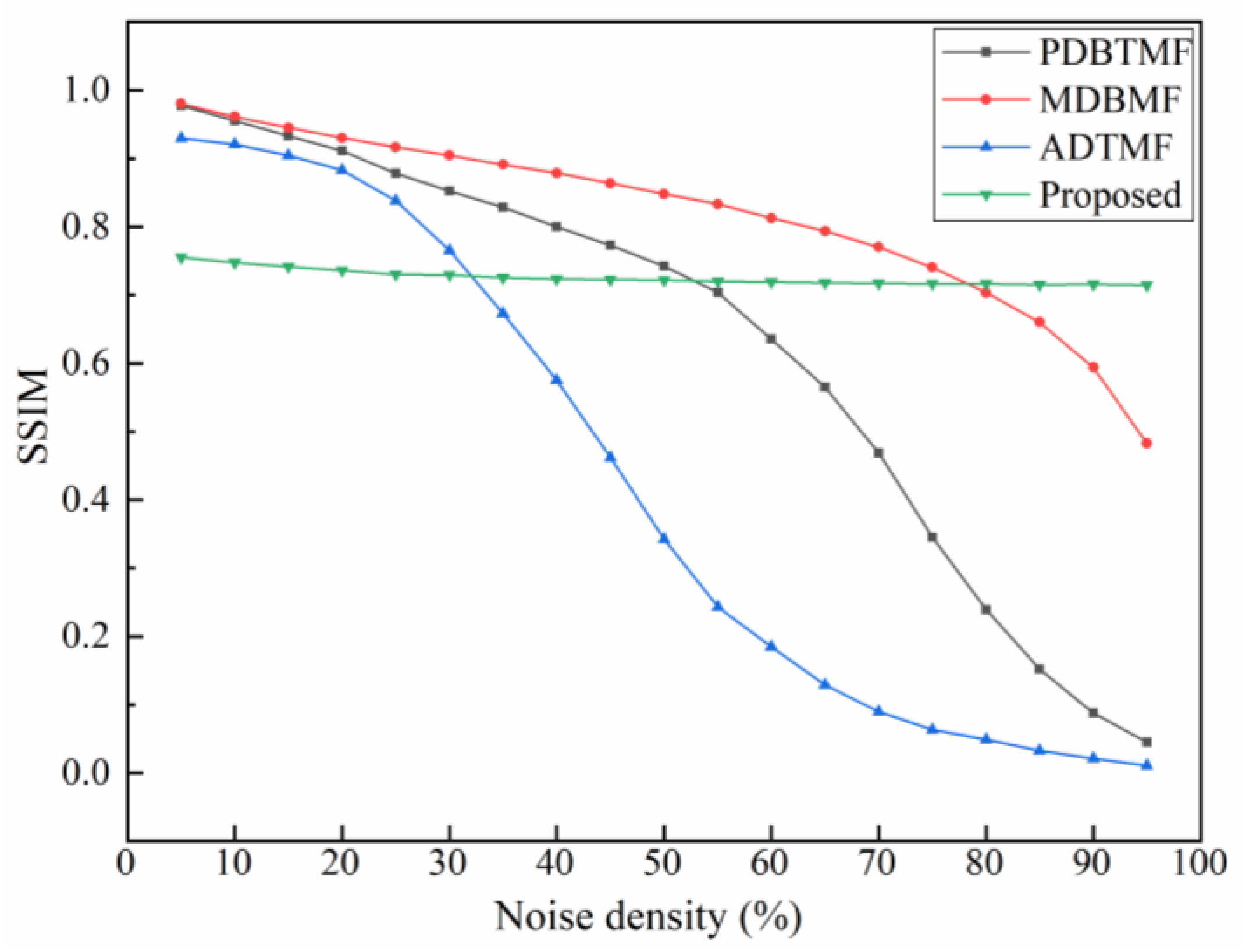
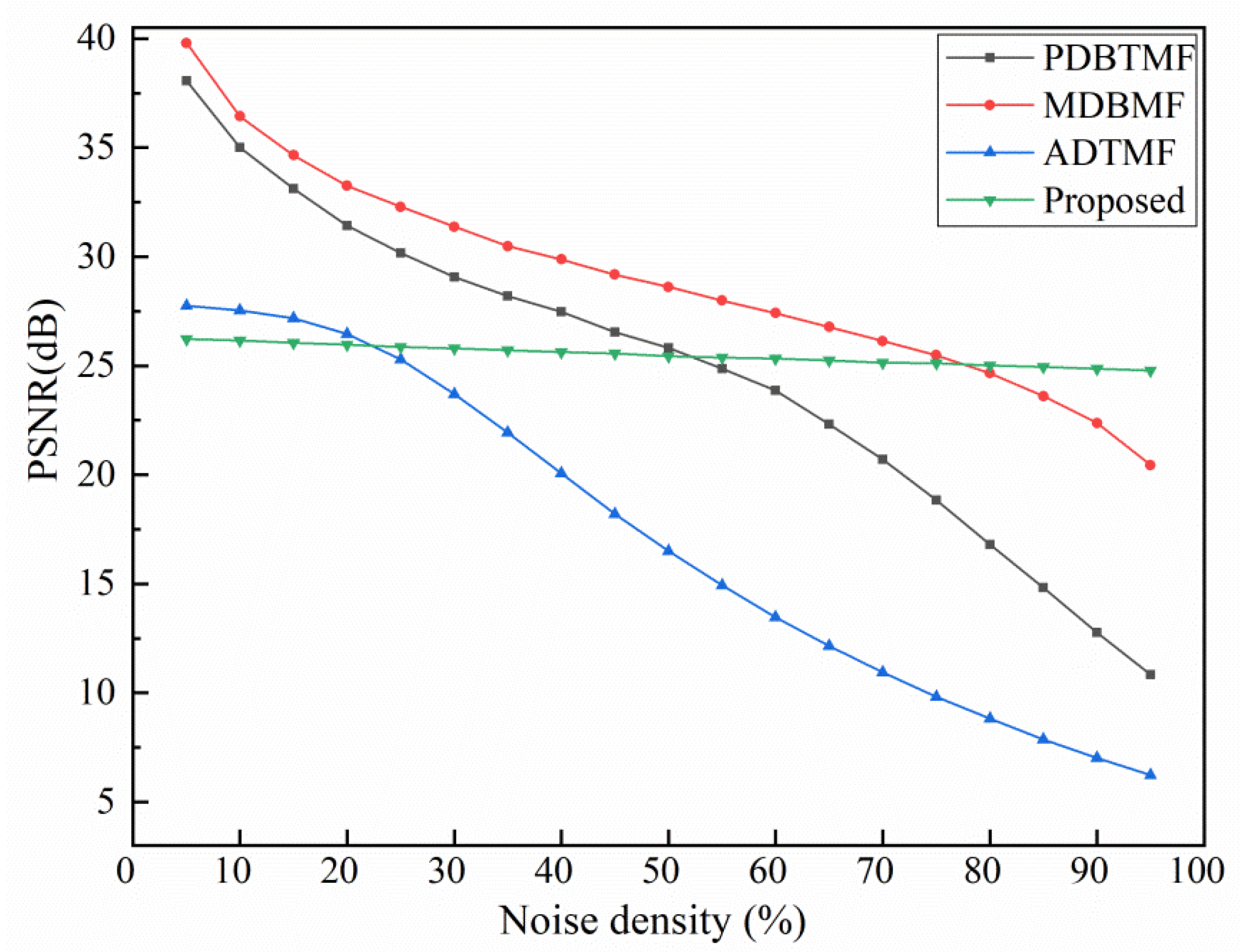
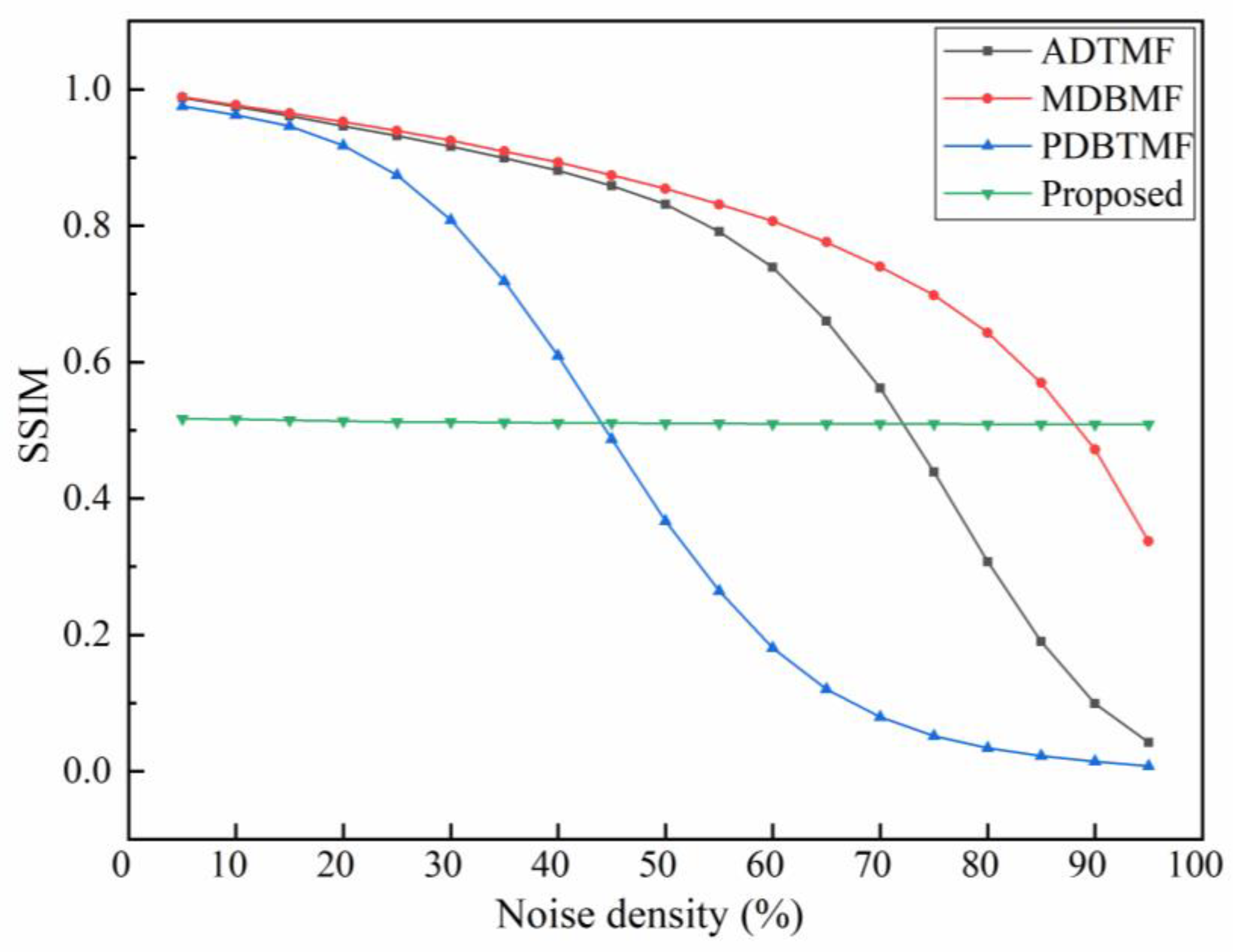
Disclaimer/Publisher’s Note: The statements, opinions and data contained in all publications are solely those of the individual author(s) and contributor(s) and not of MDPI and/or the editor(s). MDPI and/or the editor(s) disclaim responsibility for any injury to people or property resulting from any ideas, methods, instructions or products referred to in the content. |
© 2024 by the authors. Licensee MDPI, Basel, Switzerland. This article is an open access article distributed under the terms and conditions of the Creative Commons Attribution (CC BY) license (https://creativecommons.org/licenses/by/4.0/).
Share and Cite
Cao, N.; Liu, Y. High-Noise Grayscale Image Denoising Using an Improved Median Filter for the Adaptive Selection of a Threshold. Appl. Sci. 2024, 14, 635. https://doi.org/10.3390/app14020635
Cao N, Liu Y. High-Noise Grayscale Image Denoising Using an Improved Median Filter for the Adaptive Selection of a Threshold. Applied Sciences. 2024; 14(2):635. https://doi.org/10.3390/app14020635
Chicago/Turabian StyleCao, Ning, and Yupu Liu. 2024. "High-Noise Grayscale Image Denoising Using an Improved Median Filter for the Adaptive Selection of a Threshold" Applied Sciences 14, no. 2: 635. https://doi.org/10.3390/app14020635
APA StyleCao, N., & Liu, Y. (2024). High-Noise Grayscale Image Denoising Using an Improved Median Filter for the Adaptive Selection of a Threshold. Applied Sciences, 14(2), 635. https://doi.org/10.3390/app14020635



